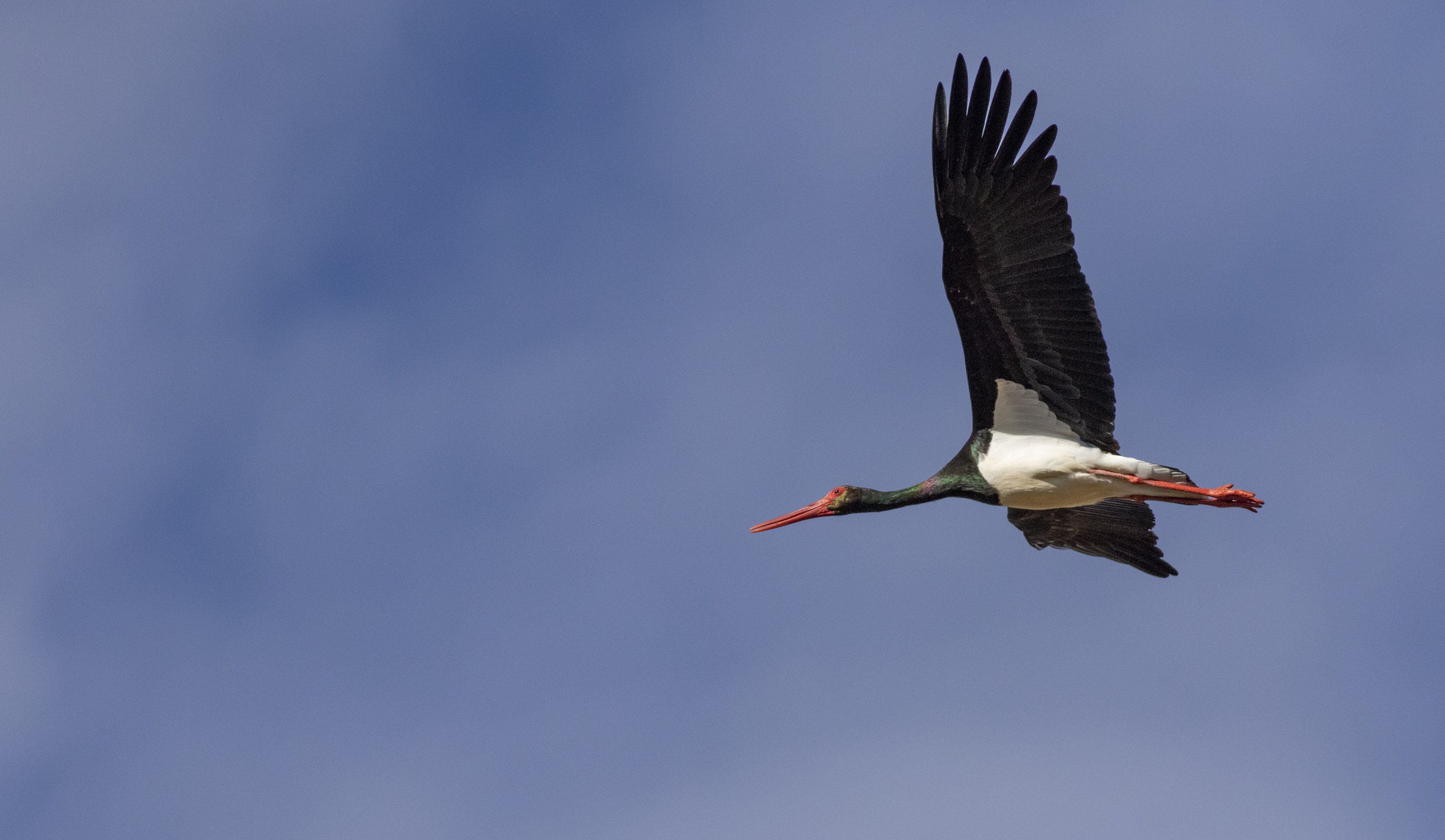Black Stork (Ciconia nigra)
CAR summary data
Habitat and noted behaviour
Sightings per Kilometre
Please note: The below charts indicate the sightings of individuals along routes where the species has occured, and NOT across all routes surveyed through the CAR project.
Regional Status

IUCN Data (Global)
IUCN 2024. IUCN Red List of Threatened Species. Version 2024-1 (www)Assessment year: 2025
Assessment Citation
BirdLife International 2025. Ciconia nigra. The IUCN Red List of Threatened Species 2025: e.T22697669A281840802. Accessed on 10 December 2025.Habitats:
Behaviour Most populations of this species are fully migratory and travel on a narrow front (del Hoyo et al. 1992) along well-defined routes (Brown et al. 1982, Hancock et al. 1992). Some breeding populations (e.g. in Spain) are also sedentary, and southern African breeding birds disperse locally after breeding (often with altitudinal movements) (del Hoyo et al. 1992). The species is a solitary nester, the timing of breeding varying between populations but generally coinciding with the local spring in the Palearctic Region and southern Africa (del Hoyo et al. 1992). On migration the species may travel singly (Snow and Perrins 1998) or in small groups (del Hoyo et al. 1992) of up to 100 individuals (Snow and Perrins 1998), and on its wintering grounds it is normally observed singly or in small groups of less than 30 individuals (Brown et al. 1982) (although it may also roost communally in South Africa) (Brown et al. 1982). Habitat The species inhabits old, undisturbed, open forests (del Hoyo et al. 1992, Snow and Perrins 1998) from sea-level up to mountainous regions (e.g. 2,000-2,500 m in altitude) (Hancock et al. 1992). It forages in shallow streams, pools, marshes (del Hoyo et al. 1992), swampy patches (Snow and Perrins 1998), damp meadows (Hancock et al. 1992), flood-plains, pools in dry riverbeds (Hockey et al. 2005) and occasionally grasslands (del Hoyo et al. 1992) especially where there are stands of reeds or long grass (Brown et al. 1982). It generally avoids large bodies of water and dense forest (del Hoyo et al. 1992), but non-breeding birds may frequent the estuaries of tidal rivers in South Africa (Hancock et al. 1992). Diet It is predominantly piscivorous although it may also take amphibians, insects, snails, crabs, small reptiles, mammals and birds (del Hoyo et al. 1992). Breeding site The nest is a large construction of sticks (del Hoyo et al. 1992) positioned between 4-25 m high (Hancock et al. 1992) in large forest trees (del Hoyo et al. 1992, Lohmus and Sellis 2003) or on cliffs (southern Africa and Spain) (del Hoyo et al. 1992). The species shows a preference for nesting in trees that have canopies large enough to hold the nest away from the main trunk (e.g. trees 25 m high, 120 years old and with a diameter at breast height of 66 cm) (Lohmus and Sellis 2003). It nests solitarily, with pairs spread out in the landscape at a distance of no less than 1 km (even where the species is most numerous) (Hancock et al. 1992). The species may occupy the nests of other bird species such as Aquila verreauxi or Hamerkop Scopus umbretta and commonly reuses nests in successive years (del Hoyo et al. 1992). Management information A study in Estonia found that the retention of large older trees during forest management is important in providing nesting sites for the species (Lohmus and Sellis 2003). Conservation measures aimed at increasing the species's breeding success and population density should cover large territories of predominantly deciduous woodland and should focus on managing the river quality as far as 20 km away from nesting sites, protecting and managing feeding habitats, and improving food resources by establishing shallow artificial pools in grasslands or along rivers (Jiguet and Villarubias 2004).Population:
In Europe, the total population size is estimated at 20,200-32,400 mature individuals, with 10,100-16,200 breeding pairs (BirdLife International 2021), and comprises under a quarter (c. 20%) of the species' global range. The global population size is estimated at 32,110-63,100 individuals (Wetlands International 2023), which equates to 21,400-42,100 mature individuals.Threats:
The main threat to this species is habitat degradation (Hancock et al. 1992, del Hoyo et al. 1992, Balian et al. 2002, Lohmus and Sellis 2003, Diagana et al. 2006). The area of suitable habitat available for breeding is being reduced in Russia and Eastern Europe through deforestation (del Hoyo et al. 1992) (particularly the destruction of large traditional nesting trees) (Hancock et al. 1992, Lohmus and Sellis 2003), the rapid development of industry and farming (Hancock et al. 1992), the building of dams (Diagana et al. 2006) and lake drainage for irrigation and hydroelectric power production (Balian et al. 2002). The species's wetland wintering habitats in Africa are further threatened by conversion (del Hoyo et al. 1992), agricultural intensification, desertification and pollution caused by the concentration of pesticides and other chemicals (del Hoyo et al. 1992, Diagana et al. 2006). The species is also occasionally killed by collisions with power-lines and overhead cables (Hockey et al. 2005), and hunting in southern Europe and tropical Asia (especially during migration) have caused population declines (Hancock et al. 1992).Conservation measures:
Conservation Actions UnderwayThe species is listed on Annex I of the EU Birds Directive, Annex II of the Bern Convention, Annex II of the Convention on Migratory Species, under which it is covered by the African-Eurasian Waterbird Agreement (AEWA) and on Annex II of the Cites Convention. Wetlands International has published a Conservation Action Plan for the species in Africa, focusing on the wintering conditions of the birds breeding in Europe (Diagana et al. 2006).
Conservation Actions Proposed
The following information refers to the species's European range only: A study in Estonia found that the retention of large older trees during forest management is important in providing nesting sites for the species (Lohmus and Sellis 2003). Conservation measures aimed at increasing the species's breeding success and population density should cover large territories of predominantly deciduous woodland and should focus on managing the river quality as far as 20 km away from nesting sites, protecting and managing feeding habitats, and improving food resources by establishing shallow artificial pools in grasslands or along rivers (Jiguet and Villarubias 2004). Other measures should: Monitor breeding, migrating, wintering numbers, age composition and ecological changes at key sites; Sustainably manage rivers and small streams; Establish non-intrusion zones around nest locations; Protect nesting trees (also in plantations) and rocks; Bury power-lines or replace with more visible cable; Prevent poaching and overexploitation of fish.
 Login
Login



